




 goto source
goto sourcesecond page:- "... This Province, King Stephen, to purchase favour with the Scots, what time he stood in most need of ayd, confirmed by gift under their Crowne; which Henry the second notwithstanding, made claime unto and got, as Newbrigensis writeth, and laid it againe in the Marches of England: since when, many bickerings betwixt these Nations herein have hapned, but none so fore against the Scotish, as was that at Sollome-Mosse, where their Nobilitie disdaining their own Generall Oliver Sinclere, gave over the Battle, and yielded themselves to the English; which dishonour pierced so deeply into the heart of King James the fist, that for griefe thereof he shortely after died."
placename:- Solommoss
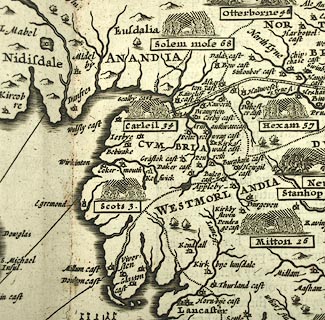 click to enlarge
click to enlargeSP25Cm.jpg
Map, uncoloured engraving, The Invasions of England and Ireland, scale roughly 28 miles to 1 inch, by John Speed? published by Thomas Bassett, The George, Fleet Street, and Richard Chiswell, The Rose and Crown, St Paul's Churchyard, London, 1676.
printed at pp.6-8:- "... / (68) At Solommoss 15000 Scots under the leading of the L. Maxwel by Tho. bastard of Dacres, and Jack Musgrave, were valiantly vanquished, and 21 of their Nobility (whereof eight were Earls) brought as prisoners to London, and 200 more of great account, besides 800 common souldiers slain and taken; for very grief whereof Kiing James fell sick, and shortly after died, 1542. H.8. 32. / ..."
item:- Armitt Library : A6632.8
Image © see bottom of page

SP11NY36.jpg
tent symbol on Solway Moss
item:- private collection : 16
Image © see bottom of page
placename:- Sollome Moss
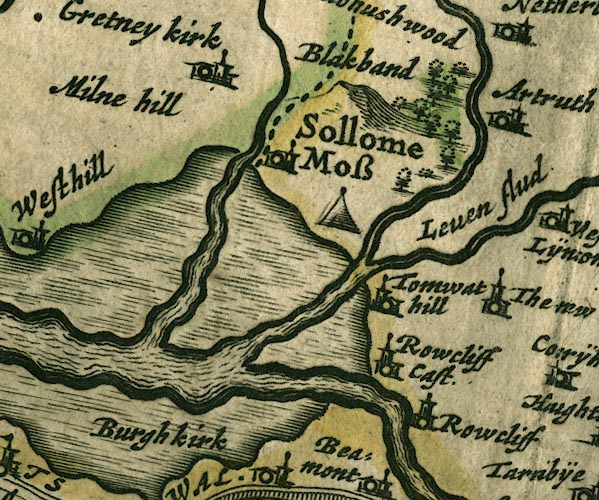
JAN3NY36.jpg
"Sollome Moss"
Tent symbol.
item:- JandMN : 88
Image © see bottom of page
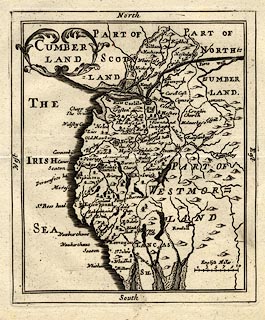 click to enlarge
click to enlargeSEL9.jpg
tent symbol; battle
item:- Dove Cottage : 2007.38.89
Image © see bottom of page
placename:- Battle of Sollome Mosse
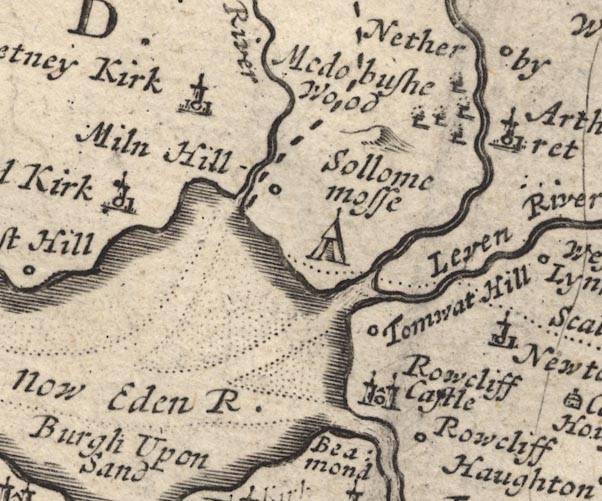
MD12NY36.jpg
"Sollome mosse"
Labelling a tent symbol for a battle site or the moss itself.
item:- JandMN : 90
Image © see bottom of page
placename:- Sollom Mosse
 goto source
goto source"..."
"Beyond the Esk, the County for some Miles is reckon'd English Ground, and in that Compass, is Sollom-Mosse, a Place remarkable for the Success of the English, in taking many Scotch Noblemen Prisoners in 1542; the Occasion was this: The Scots being ready to join Battle, contrary to their Expectation, found that Sir Oliver Sinclair was appointed their General, a Person who not only lay under a general Odium, but being of an inferior Rank, the Noblemen took it as an Affront to them to be commanded by him; and to revenge the Injury, as they call'd it, fell into Mutinies and Disorder."
 goto source
goto source"The English commanded by Sir Thomas Wharton, being posted upon the higher Ground, observed this Advantage, and falling upon him put them to Flight, and took many Prisoners, without any Blood, among whom were the Earl of Cassels and Glencarn, the Lords Maxwel, Fleming, Sir Oliver Sinclair, and many others. James V. King of Scotland, was so much concern'd for the Loss of his Army, which consisted of 15,000 Men, that he soon after died of Grief. ..."
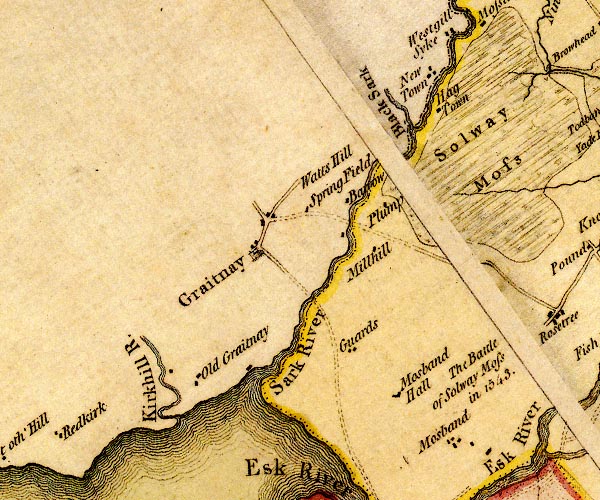
D4NY36NW.jpg
"The Battle of Solway Moss in 1543."
battle site
item:- Carlisle Library : Map 2
Image © Carlisle Library
placename:- batle site, Sollom Moss
 goto source
goto sourcePage 160:- "..."
"Of this battle at Sollom Moss, (now called Solway Moss,) so many historians speak that it is needless for me: I shall only insert a copy of the order of Sir Thomas Whar-"
 goto source
goto sourcePage 161:- "[Whar]ton for muster, which was found in a manuscript of Theodorus Sisson, who was one of his Majesty's justices of the peace for the county of Westmorland, and who resided at Barton, the only place summoned in that county. - He says, that the whole of Sir Thomas Wharton's force did not exceed 1000 men, (some historians have called them only 300,) and that they engaged an army of 15,000 Scots, and took prisoners almost every person of distinction in the Scots army, and eight or nine hundred common soldiers, with all their baggage. The reason given by the Scots was, that not knowing who was their commander in chief on the day of the battle, Oliver Sinclair, the King's favourite, being lifted upon the shoulders of two of his soldiers, shewed the King's commission, wherein himself was appointed their General, wherewith the Scots were so displeased, that they refused to fight, and suffered themselves to be taken prisoners."
"The names of these Lords sent for by Sir Thomas Wharton in 1543, for Defence of the Borders."
"One cannot, from the above, tell what number there was, and the further account being defaced, I could read little of it, except total of men, 1027."
| Bewcastle, | John Musgrave, horse and foot. |
| Gillsland, | Thomas Blenerhasset, 60 horse. |
| Warwickbriggs, | Richard Warwick, and tenants. Alexander Appleby, 2 horse. William Porter, 2 horse. Anthony Highmore, 4 horse. |
| For Ainstable, | Edward Aglionby, horse and foot. Robert Brisco, horse and foot. |
| Penrith, | Cuthbert Hutton, 6 horse, 10 foot. |
| Greystock, | Thomas Dacre, horse and foot. |
| Barton, Martindale and Patterdale, | William Pickering, 20 horse, 20 foot. |
| Threlkeld, | Chris. Threlkeld, 4 horse, 6 foot. |
| For Derwentwater estates, | Lancelot Lowther, all horse and foot. |
| [torn here] Lord Millum, | Mr Latus, 60 horse. |
| Calder, | John Senhouse, 4 horse. |
| Mulcaster, | William Pennington, all horse. |
| Whithaven, &c. | Sir John Lowther, 100 horse, 40 foot. |
| Workington, | Sir Thomas Curwen, horse and foot. John Lamplough, 10 horse, 4 foot. |
| Wardel Hall, | Thomas Dykes, 4 horse. Richard Eglesfield, 6 horse. John Senhouse, 4 horse. Anthony Barwise, 2 horse. William Asmotherly, 2 horse. John Swinburn, household servants. Lord of St Bees, 10 horse. Robert Lamplugh, household servants. Robert Ellis, 2 horse. John Thwaites, household servants. |
| Branthwaite and Lowswater, | John Skelton, 4 horse. Sir William Musgrave, 100 horse, 40 foot. John Leigh, 10 horse. |
| Whitehall, | Thomas Salkeld, 4 horse. William Skelton, 6 horse. |
| Dalston, | Thomas Dalston, 10 horse, 20 foot. |
| Catterelend, | William Vaux, 4 horse, 6 foot. |
| Blencow, | Richard Blencow, 6 horse. Bishops Tenants, 40 horse. Abbey Holm, all tried horse. |
 goto source
goto sourcePage 176:- "..."
"... Beyond this river Esk the country for some miles is accounted part of England, in which is Sollom-mosse, famous for the number of Scottish nobles taken prisoners A.D. 1543, when the Scots intending to attack Thomas Wharton, lord warden of the Marches, no sooner found the king had transferred his command to Oliver Sincler, in preference to them, than they resented this affront as they supposed it, to their own disgrace and ruin, breaking their ranks, and throwing the whole army into confusion. The English seeing this from higher ground immediately attacked and routed them, made many prisoners, who flung down their arms and surrendered themselves to the English and moss troopers on the borders with an inconsiderable loss of men on either side; which threw king James V. of Scotland into such despondency that he broke his heart. ..."
item:- armour
 goto source
goto sourcePage 188:- "..."
"... Within it [Arthuret] lies a noted morass, commonly called Solom moss, ... It is famous in history for the defeat of the Scots in Henry VIII's time by sir Thomas Wharton, of which see before, p.51. 156. The few Scotch runaways of 1524 perished in this moss, and some peat diggers are said to have found in it a few years ago the skeleton of a trooper and his horse in complete armour."
item:- Battle of Solway Moss
 goto source
goto sourceGentleman's Magazine 1816 part 2 p.600
From the Compendium of County History:- "1542, at Solway Moss, the Scots, under Sir Oliver Sinclair, favourite of James V. routed, and their principal Nobles taken, by Sir Thomas Dacre and Sir John Musgrave."
item:- incursion, 1542
HP01p157.txt
Page 157:- "..."
"Solway Moss is marked on the maps with the conventional crossed swords that indicate a battle. It was not an epoch making battle that was fought here, November 24th, 1542, but it was of the most complete of English victories, and the story of it is compact of a peculiar terror. The Scots had crossed the Border in force, and were proceeding on their usual lines of fire and pillage, to the assault of Carlisle, when they were met at Arthuret by an army under Sir Thomas Wharton, the stout Warden of the West Marches. The English onset disorganised the invaders, who fled in the gathering darkness. Ten thousand fugitives lost their way, and found themselves with the flowing tide upon the fatal Solway Sands. Some flung away their arms and struggled through, thousands were drowned, and many surrendered to"
HP01p158.txt
Page 158:- "women. Meanwhile, the main body, pursued by the English, wandered in the other direction across the Esk and plunged into the bog of Solway Moss, and were swallowed up, slain, or taken prisoners. "Never," says Froude, "in all the wars between England and Scotland, had there been a defeat more complete, more sudden, or more disgraceful." James the Fifth of Scotland died on December 14th, heart-broken at the disaster. It was a complete English revenge for the defeat they had suffered at the Sark, hard by, in 1449, nearly a hundred years before."
